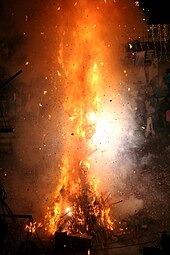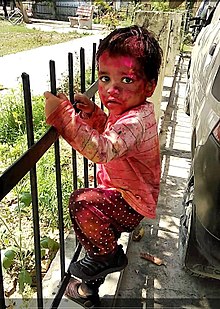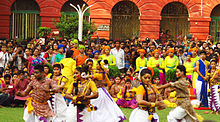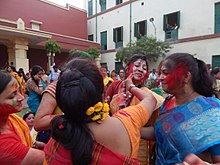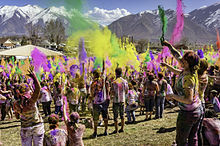| Holi Festival of Colours | |
|---|---|
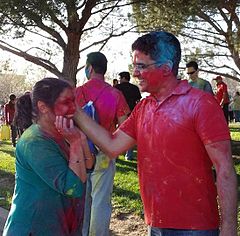
Holi celebration
| |
| Observed by | Hindus,[1] Sikhs, also some Jains,[2] Newar Buddhists[3] and other non-Hindus[4] |
| Type | religious, cultural, spring festival |
| Celebrations | Night before: Holika Bonfire On Holi: spray colours on others, dance, party; eat festival delicacies[5] |
| Date | per Hindu calendar[note 1] |
| 2019 date | Thursday, 21 March |
| 2020 date | Monday, 9 March |
| Frequency | annual |
| Part of a series on |
| Hinduism |
|---|
 |
Holi celebration at Haridwar
Holi celebrations start on the night before Holi with a Holika Dahan where people gather, perform religious rituals in front of the bonfire, and pray that their internal evil be destroyed the way Holika, the sister of the demon king Hiranyakashipu, was killed in the fire. The next morning is celebrated as Rangwali Holi – a free-for-all festival of colours,[10] where people smear each other with colours and drench each other. Water guns and water-filled balloons are also used to play and colour each other. Anyone and everyone is fair game, friend or stranger, rich or poor, man or woman, children and elders. The frolic and fight with colours occurs in the open streets, open parks, outside temples and buildings. Groups carry drums and other musical instruments, go from place to place, sing and dance. People visit family, friends and foes to throw coloured powders on each other, laugh and gossip, then share Holi delicacies, food and drinks.[19][20] Some customary drinks include bhang (made from cannabis), which is intoxicating.[21][22] In the evening, after sobering up, people dress up and visit friends and family.[5][19]
Significance
Vishnu legend
There is a symbolic legend to explain why Holi is celebrated as a festival of colours in the honour of Hindu god Vishnu and his follower Prahlada. King Hiranyakashipu, according to a legend found in chapter 7 of Bhagavata Purana,[23][24] was the king of demonic Asuras, and had earned a boon that gave him five special powers: he could be killed by neither a human being nor an animal, neither indoors nor outdoors, neither at day nor at night, neither by astra (projectile weapons) nor by any shastra (handheld weapons), and neither on land nor in water or air. Hiranyakashipu grew arrogant, thought he was God, and demanded that everyone worship only him.[5]Hiranyakashipu's own son, Prahlada, however, disagreed. He was and remained devoted to Vishnu.[19] This infuriated Hiranyakashipu. He subjected Prahlada to cruel punishments, none of which affected the boy or his resolve to do what he thought was right. Finally, Holika, Prahlada's evil aunt, tricked him into sitting on a pyre with her.[5] Holika was wearing a cloak that made her immune to injury from fire, while Prahlada was not. As the fire roared, the cloak flew from Holika and encased Prahlada,[19] who survived while Holika burned. Vishnu, the god who appears as an avatar to restore Dharma in Hindu beliefs, took the form of Narasimha - half human and half lion, at dusk (when it was neither day nor night), took Hiranyakashyapu at a doorstep (which was neither indoors nor outdoors), placed him on his lap (which was neither land, water nor air), and then eviscerated and killed the king with his lion claws (which were neither a handheld weapon nor a launched weapon).[25]
The Holika bonfire and Holi signifies the celebration of the symbolic victory of good over evil, of Prahlada over Hiranyakashipu, and of the fire that burned Holika.[11]
Krishna legend
In the Braj region of India, where the Hindu deity Krishna grew up, the festival is celebrated until Rang Panchmi in commemoration of the divine love of Radha for Krishna. The festivities officially usher in spring, with Holi celebrated as a festival of love.[26] There is a symbolic myth behind commemorating Krishna as well. As a baby, Krishna developed his characteristic dark skin colour because the she-demon Putana poisoned him with her breast milk.[27] In his youth, Krishna despaired whether the fair-skinned Radha and other girls would like him because of his skin colour. His mother, tired of the desperation, asks him to approach Radha and ask her to colour his face in any colour she wanted. This she does, and Radha and Krishna became a couple. Ever since, the playful colouring of Radha and Krishna's face has been commemorated as Holi.[28][29] Beyond India, these legends help to explain the significance of Holi (Phagwah) are common in some Caribbean and South American communities of Indian origin such as Guyana and Trinidad and Tobago.[30][31] It is also celebrated with great fervour in Mauritius.[32]Other Hindu traditions
Among other Hindu traditions such as Shaivism and Shaktism, the legendary significance of Holi is linked to Shiva in yoga and deep meditation, goddess Parvati wanting to bring back Shiva into the world, seeks help from the Hindu god of love called Kama on Vasant Panchami. The love god shoots arrows at Shiva, the yogi opens his third eye and burns Kama to ashes. This upsets both Kama's wife Rati (Kamadevi) and his own wife Parvati. Rati performs her own meditative asceticism for forty days, upon which Shiva understands, forgives out of compassion and restores the god of love. This return of the god of love, is celebrated on the 40th day after Vasant Panchami festival as Holi.[33][34] The Kama legend and its significance to Holi has many variant forms, particularly in South India.[35]Cultural significance
The Holi festival has a cultural significance among various Hindu traditions of the Indian subcontinent. It is the festive day to end and rid oneself of past errors, to end conflicts by meeting others, a day to forget and forgive. People pay or forgive debts, as well as deal anew with those in their lives. Holi also marks the start of spring, for many the start of the new year, an occasion for people to enjoy the changing seasons and make new friends.[11][36]Other Indian religions
The festival has traditionally been also observed by non-Hindus, such as by Jains[2] and Newar Buddhists (Nepal).[3]Sikhs have traditionally celebrated the festival, at least through the 19th century,[37] with its historic texts referring to it as Hola.[38] Guru Gobind Singh – the last human guru of the Sikhs – modified Holi with a three-day Hola Mohalla extension festival of martial arts. The extension started the day after the Holi festival in Anandpur Sahib, where Sikh soldiers would train in mock battles, compete in horsemanship, athletics, archery and military exercises.[39][40][41]
Holi was observed by Maharaja Ranjit Singh and his Sikh Empire that extended across what are now northern parts of India and Pakistan. According to a report by Tribune India, Sikh court records state that 300 mounds of colours were used in 1837 by Ranjit Singh and his officials in Lahore. Ranjit Singh would celebrate Holi with others in the Bilawal gardens, where decorative tents were set up. In 1837, Sir Henry Fane who was the commander-in-chief of the British Indian army joined the Holi celebrations organised by Ranjit Singh. A mural in the Lahore Fort was sponsored by Ranjit Singh and it showed the Hindu god Krishna playing Holi with gopis. After the death of Ranjit Singh, his Sikh sons and others continued to play Holi every year with colours and lavish festivities. The colonial British officials joined these celebrations.[42]
Description
Holi is an important spring festival for Hindus, a national holiday in India and Nepal with regional holidays in other countries. To many Hindus and some non-Hindus, it is a playful cultural event and an excuse to throw coloured water at friends or strangers in jest. It is also observed broadly in the Indian subcontinent. Holi is celebrated at the end of winter, on the last full moon day of the Hindu luni-solar calendar month marking the spring, making the date vary with the lunar cycle.[note 1] The date falls typically in March, but sometimes late February of the Gregorian calendar.[45][46]It also has a religious purpose, symbolically signified by the legend of Holika. The night before Holi, bonfires are lit in a ceremony known as Holika Dahan (burning of Holika) or Little Holi. People gather near fires, sing and dance. The next day, Holi, also known as Dhuli in Sanskrit, or Dhulheti, Dhulandi or Dhulendi, is celebrated.
In Northern parts of India, Children and youth spray coloured powder solutions (gulal) at each other, laugh and celebrate, while adults smear dry coloured powder (abir) on each other's faces.[5][36] Visitors to homes are first teased with colours, then served with Holi delicacies (such as puranpoli, dahi-bada and gujia), desserts and drinks.[20][48][49] After playing with colours, and cleaning up, people bathe, put on clean clothes, and visit friends and family.[11]
Like Holika Dahan, Kama Dahanam is celebrated in some parts of India. The festival of colours in these parts is called Rangapanchami, and occurs on the fifth day after Poornima (full moon).[50]
History and rituals
The Holi festival is an ancient Hindu festival with its cultural rituals. It is mentioned in the Puranas, Dasakumara Charita, and by the poet Kālidāsa during the 4th century reign of Chandragupta II.[8] The celebration of Holi is also mentioned in the 7th-century Sanskrit drama Ratnavali.[51] The festival of Holi caught the fascination of European traders and British colonial staff by the 17th century. Various old editions of Oxford English Dictionary mention it, but with varying, phonetically derived spellings: Houly (1687), Hooly (1698), Huli (1789), Hohlee (1809), Hoolee (1825), and Holi in editions published after 1910.[10]There are several cultural rituals associated with Holi:[52]
- Prepare Holika pyre for bonfire
Shops start selling colours for Holi in the days and weeks beforehand
- Holika dahan
- Play with colours
A little kid after Holi celebrating
In the Braj
region of North India, women have the option to playfully hit men who
save themselves with shields; for the day, men are culturally expected
to accept whatever women dish out to them. This ritual is called Lath Mar Holi.[53]
Groups sing and dance, some playing drums and dholak. After each stop of fun and play with colours, people offer gujiya, mathri, malpuas and other traditional delicacies.[54] Cold drinks, including adult drinks based on local intoxicating herbs,[22] are also part of the Holi festivity.
- Other variations
Friends form groups on Holi, play drums and music, sing and dance, as they move from one stop to another.
In south India, some worship and make offerings to Kaamadeva, the love god of Indian mythology.
- The after party
Regional names, rituals and celebrations
Holi (Hindi: होली, Marathi: होळी, Nepali: होली, Punjabi: ਹੋਲੀ, Kannada: ಹೋಳಿ, Telugu: హోళి) is also known as Phakuwa or Phagwah (Assamese: ফাকুৱা), Festival of Colours, or Dola jātra (Odia: ଦୋଳଯାତ୍ରା) in Odisha, and as Dol Jatra (Assamese: দ’ল যাত্ৰা) or Basanto utsav ("spring festival") in West Bengal and Assam. The customs and celebrations vary between regions of India.
Basanto Utsav at Jorasanko Thakurbari
Outside India and Nepal, Holi is observed by the minority Hindus in Bangladesh and Pakistan as well in countries with large Indian subcontinent diaspora populations such as Suriname, Guyana, Trinidad and Tobago, South Africa, Malaysia, the United Kingdom, the United States, Canada, Australia, Mauritius, and Fiji. The Holi rituals and customs outside South Asia also vary with local adaptations.
India
This section needs additional citations for verification. (March 2018) (Learn how and when to remove this template message)
|
Gujarat
In Ahmedabad in Gujarat, in western India, a pot of buttermilk is hung high over the streets and young boys try to reach it and break it by making human pyramids. The girls try to stop them by throwing coloured water on them to commemorate the pranks of Krishna and the cowherd boys to steal butter and "gopis" while trying to stop the girls. The boy who finally manages to break the pot is crowned the Holi King. Afterwards, the men, who are now very colourful, go out in a large procession to "alert" people of Krishna's possible appearance to steal butter from their homes.
In some places there is a custom in undivided Hindu families that the woman beats her brother-in-law with a sari rolled up into a rope in a mock rage and tries to drench him with colours, and in turn, the brother-in-law brings sweets (Indian desserts) to her in the evening.[57]
Uttar Pradesh
Colour Drenched Gopis in Krishna Temple, Mathura
Mathura, in the Braj region, is the birthplace of Lord Krishna. In Vrindavan this day is celebrated with special puja and the traditional custom of worshipping Lord Krishna; here the festival lasts for sixteen days.[26] All over the Braj region [58] and neighboring places like Hathras, Aligarh, and Agra, Holi is celebrated in more or less the same way as in Mathura, Vrindavan and Barsana.
A play of colours then a dance at a Hindu temple near Mathura, at Holi.
Outside Braj, in the Kanpur area, Holi lasts seven days with colour. On the last day, a grand fair called Ganga Mela or the Holi Mela is celebrated. This Mela (fair) was started by freedom fighters who fought British rule in the First Indian War of Independence in 1857 under the leadership of Nana Saheb. The Mela is held at various ghats along the banks of the River Ganga in Kanpur, to celebrate the Hindus and Muslims who together resisted the British forces in the city in 1857. On the eve of Ganga Mela, all government offices, shops, and courts generally remain closed. The Ganga Mela marks the official end of "The Festival of Colours" or Holi in Kanpur.[citation needed]
In Gorakhpur, the northeast district of Uttar Pradesh, the day of Holi starts with a special puja. This day, called "Holi Milan", is considered to be the most colourful day of the year, promoting brotherhood among the people. People visit every house and sing Holi songs and express their gratitude by applying coloured powder (Abeer). It is also considered the beginning of the year, as it occurs on the first day of the Hindu calendar year (Panchang).[citation needed]
A natural dye-based Holi in Pune, an alternative to synthetic colours
Uttarakhand
Kumaoni Holi in Uttarakhand includes a musical affair. It takes different forms such as the Baithki Holi, the Khari Holi and the Mahila Holi. In Baithki Holi and Khari Holi, people sing songs with a touch of melody, fun and spiritualism. These songs are essentially based on classical ragas. Baithki Holi (बैठकी होली), also known as Nirvan Ki Holi, begins from the premises of temples, where Holiyars (होल्यार) sing Holi songs and people gather to participate, along with playing classical music. The songs are sung in a particular sequence depending on the time of day; for instance, at noon the songs are based on Peelu, Bhimpalasi and Sarang ragas, while evening songs are based on the ragas such as Kalyan, Shyamkalyan and Yaman. The Khari Holi (खड़ी होली) is mostly celebrated in the rural areas of Kumaon. The songs of the Khari Holi are sung by the people, who, sporting traditional white churidar payajama and kurta, dance in groups to the tune of ethnic musical instruments such as the dhol and hurka.[citation needed]In the Kumaon region, the Holika pyre, known as Cheer (चीर), is ceremonially built in a ceremony known as Cheer Bandhan (चीर बंधन) fifteen days before Dulhendi. The Cheer is a bonfire with a green Paiya tree branch in the middle. The Cheer of every village and neighborhood is rigorously guarded as rival mohallas try to playfully steal each other's cheer.[citation needed]
The colours used on Holi are derived from natural sources. Dulhendi, known as Charadi (छरड़ी) (from Chharad (छरड़)), is made from flower extracts, ash and water. Holi is celebrated with great gusto much in the same way all across North India.[62]
Bihar/Jharkhand
Holi is known as Phaguwa in the local Bhojpuri dialect. In this region as well, the legend of Holika is prevalent. On the eve of Phalgun Poornima, people light bonfires. They put dried cow dung cakes, wood of the Araad or Redi tree and Holika tree, grains from the fresh harvest and unwanted wood leaves in the bonfire. At the time of Holika people assemble near the pyre. The eldest member of the gathering or a purohit initiates the lighting. He then smears others with colour as a mark of greeting. Next day the festival is celebrated with colours and a lot of frolic. Traditionally, people also clean their houses to mark the festival.[citation needed]Holi Milan is also observed in Bihar, where family members and well wishers visit each other's family, apply colours (abeer) on each other's faces, and on feet, if elderly. Usually this takes place on the evening of Holi day after Holi with wet colours is played in the morning through afternoon. Due to large-scale internal migration issues faced by the people, recently this tradition has slowly begun to transform, and it is common to have Holi Milan on an entirely different day either before or after the actual day of Holi.[citation needed]
Children and youths take extreme delight in the festival. Though the festival is usually celebrated with colours, in some places people also enjoy celebrating Holi with water solutions of mud or clay. Folk songs are sung at high pitch and people dance to the sound of the dholak (a two-headed hand-drum) and the spirit of Holi. Intoxicating bhang, made from cannabis, milk and spices, is consumed with a variety of mouth-watering delicacies, such as pakoras and thandai, to enhance the mood of the festival.[63]
Odisha
An 1822 drawing showing elevation of a black stone arch in Puri, Odisha. It carried Vaishnavite gods and goddess, the ritual noted to be a part of the Holi festival.[64]
West Bengal
Dol Khela in Kolkata at Thakurbari
Basanta Utsab at Jorasanko Thakur Bari in 2015
Assam
Holi, also called Phakuwa (ফাকুৱা) in Assamese, is celebrated all over Assam. Locally called Dol Jatra, associated with Satras of Barpeta, Holi is celebrated over two days. On the first day, the burning of clay huts are seen in Barpeta and lower Assam which signifies the legends of Holika. On the second day of it, Holi is celebrated with colour powders. The Holi songs in chorus devoted to Lord Krishna are also sung in the regions of Barpeta.Goa
Holi is locally called Ukkuli in Konkani. It is celebrated around the Konkani temple called Gosripuram temple. It is a part of the Goan or Konkani spring festival known as Śigmo or शिगमो in Koṅkaṇī or Śiśirotsava, which lasts for about a month. The colour festival or Holi is a part of longer, more extensive spring festival celebrations.[67] Holi festivities (but not Śigmo festivities) include: Holika Puja and Dahan, Dhulvad or Dhuli vandan, Haldune or offering yellow and saffron colour or Gulal to the deity.Maharashtra
In Maharashtra, Holi Purnima is also celebrated as Shimga, festivities that last five to seven days. A week before the festival, youngsters go around the community, collecting firewood and money. On the day of Shimga, the firewood is heaped into a huge pile in each neighborhood. In the evening, the fire is lit. Every household brings a meal and dessert, in the honour of the fire god. Puran Poli is the main delicacy and children shout "Holi re Holi puranachi poli". Shimga celebrates the elimination of all evil. The colour celebrations here take place on the day of Rang Panchami, five days after Shimga. During this festival, people are supposed to forget and forgive any rivalries and start new healthy relations with all.
Children celebrating Holi at Pune city in Maharashtra
Manipur
Manipuris celebrate Holi for 6 days. Here, this holiday merges with the festival of Yaosang. Traditionally, the festival commences with the burning of a thatched hut of hay and twigs. Young children go from house to house to collect money, locally known as nakadeng (or nakatheng), as gifts on the first two days. The youths at night perform a group folk dance called Thabal chongba on the full moon night of Lamta (Phalgun), traditionally accompanied by folk songs and rhythmic beats of the indigenous drum, but nowadays by modern bands and fluorescent lamps. In Krishna temples, devotees sing devotional songs, perform dances and celebrate with aber (gulal) wearing traditional white and yellow turbans. On the last day of the festival, large processions are taken out to the main Krishna temple near Imphal where several cultural activities are held. In recent decades, Yaosang, a type of Indian sport, has become common in many places of the valley, where people of all ages come out to participate in a number of sports that are somewhat altered for the holiday.Karnataka
Traditionally, in rural Karnataka children collect money and wood in the weeks prior to Holi, and on "Kamadahana" night all the wood is put together and lit. The festival is celebrated for two days. People in northern parts of Karnataka prepare special food on this day.
Holi Celebration in Andhra Pradesh
Telangana
Holi celebration at Hyderabad
Hindus celebrate Holi as it relates to the legend of Kama Deva. Holi is known by three names: Kamavilas, Kaman Pandigai and Kama-Dahanam[69][70][71][72]
Jammu & Kashmir
In Jammu & Kashmir, Holi celebrations are much in line with the general definition of Holi celebrations: a high-spirited festival to mark the beginning of the harvesting of the summer crop, with the throwing of coloured water and powder and singing and dancing.[citation needed]Punjab & Himachal Pradesh
In Punjab, Holi is preceded by Holika Dahan the night before. On the day of Holi, people engage in throwing colours[73] on each other.[74] For locals, Holi marks the end of winter. The Punjabi saying 'Phaggan phal laggan' (Phagun is the month for fructifying) exemplifies the seasonal aspect of Holi. Trees and plants start blossoming from the day of Basant and start bearing fruit by Holi.[75]During Holi in Punjab, walls and courtyards of rural houses are enhanced with drawings and paintings similar to rangoli in South India, mandana in Rajasthan, and rural arts in other parts of India. This art is known as chowk-poorana or chowkpurana in Punjab and is given shape by the peasant women of the state. In courtyards, this art is drawn on cloth. The art includes drawing tree motifs, flowers, ferns, creepers, plants, peacocks, palanquins, geometric patterns along with vertical, horizontal and oblique lines. These arts add to the festive atmosphere.[76]
Folk theatrical performances known as swang or nautanki take place during Holi,[77] with the latter originating in the Punjab.[78] According to Self (1993), Holi fairs are held in the Punjab which may go on for many days.[79] Bose (1961) states that "in some parts of the Punjab, holi is celebrated with wrestling matches".[80]
Nepal
Preparing for Holika Dahan, Kathamandu, Nepal
Locals Celebrating Holi In Kathmandu, Nepal
People walk through their neighbourhoods to celebrate Holi by exchanging colours and spraying coloured water on one another. A popular activity is the throwing of water balloons at one another, sometimes called lola (meaning water balloon).[83] Many people mix bhang in their drinks and food, as is also done during Shivaratri. It is believed that the combination of different colours at this festival takes all sorrow away and makes life itself more colourful.
Holi in Basantapur Durbar Square
Indian diaspora
Over the years, Holi has become an important festival in many regions wherever Indian diaspora were either taken as indentured labourers during colonial era, or where they emigrated on their own, and are now present in large numbers such as in Africa, North America, Europe, Latin America, and parts of Asia such as Fiji[16][18][84][85].- Suriname
A celebration of Holi Festival in the United States
- Trinidad and Tobago
- Guyana
Drummers of Indo-Caribbean community celebrating Phagwah (Holi) in New York City, 2013
- Fiji
- Mauritius
- United States
- Indonesia
Pakistan
Holi is celebrated by the minority Hindu population in Pakistan. Community events by Hindus have been reported by Pakistani media in various cities such as Karachi,[93] Hazara,[94] Rawalpindi, Sindh, Hyderabad, Multan and Lahore.[95]Holi was not a public holiday in Pakistan from 1947 to 2016. Holi along with Diwali for Hindus, and Easter for Christians, was adopted as public holiday resolution by Pakistan's parliament in 2016, giving the local governments and public institutions the right to declare Holi as a holiday and grant leave for its minority communities, for the first time.[96] This decision has been controversial, with some Pakistanis welcoming the decision, while others criticising it, with the concern that declaring Holi a public holiday advertises a Hindu festival to Pakistani children.[97]
Traditional sources of colours
Flowers of Dhak or Palash are used to make traditional colours
Many colours are obtained by mixing primary colours. Artisans produce and sell many of the colours from natural sources in dry powder form, in weeks and months preceding Holi. Some of the traditional natural plant-based sources of colours are:[10][98][99]
- Orange and red
- Green
- Yellow
Colours for Holi on sale at a market in Mysore
- Blue
- Magenta and purple
- Brown
- Black
Holi powder
Synthetic colours
A young man celebrating Holi
A 2007 study found that malachite green, a synthetic bluish-green dye used in some colours during Holi festival, was responsible for severe eye irritation in Delhi, if eyes were not washed upon exposure. Though the study found that the pigment did not penetrate through the cornea, malachite green is of concern and needs further study.[100]
Another 2009 study reports that some colours produced and sold in India contain metal-based industrial dyes, causing an increase in skin problems to some people in the days following Holi. These colours are produced in India, particularly by small informal businesses, without any quality checks and are sold freely in the market. The colours are sold without labeling, and the consumer lacks information about the source of the colours, their contents, and possible toxic effects. In recent years, several nongovernmental organisations have started campaigning for safe practices related to the use of colours. Some are producing and marketing ranges of safer colours derived from natural sources such as vegetables and flowers.[101]
These reports have galvanised a number of groups into promoting more natural celebrations of Holi. Development Alternatives, Delhi and Kalpavriksh,[102] – Kalpavriksh Environment Action Group, Pune, The CLEAN India campaign[103] and Society for Child Development, through its Avacayam Cooperative Campaign[104] have launched campaigns to help children learn to make their own colours for Holi from safer, natural ingredients. Meanwhile, some commercial companies such as the National Botanical Research Institute have begun to market "herbal" dyes, though these are substantially more expensive than the dangerous alternatives. However, it may be noted that many parts of rural India have always resorted to natural colours (and other parts of festivities more than colours) due to availability.
In urban areas, some people wear nose mask and sun glasses to avoid inhaling pigments and to prevent chemical exposure to eyes.[105]
Environmental impact
An alleged environmental issue related to the celebration of Holi is the traditional Holika bonfire, which is believed to contribute to deforestation. Activists estimate Holika causes 30,000 bonfires every year, with each one burning approximately 100 kilograms (220.46 lbs) of wood.[106] This represents less than 0.0001% of 350 million tons of wood India consumes every year, as one of the traditional fuels for cooking and other uses.[107]The use of heavy metal-based pigments during Holi is also reported to cause temporary wastewater pollution, with the water systems recovering to pre-festival levels within 5 days.[108]
Flammability
In June 2015, hundreds of concert-goers in Bali District, Taiwan were severely injured in the Formosa Fun Coast explosion, including fifteen who died later in hospital,[109] after three tons of corn starch powder mixed with food colouring was sprayed onto the crowd at a high velocity, causing a massive explosion.[110]The method of powder application at the concert created "an extremely dense dust cloud over the stage and its immediate vicinity".[111] People near the stage were standing ankle deep in coloured corn starch powder and the powder was suspended into the air using air blowers as well as compressed gas canisters.[112][113] Initial investigations into the explosion showed the ignition of the suspended corn starch powder was likely caused by a cigarette or spark. An Asia One report[114] states that such an explosion can occur, under certain conditions, not just with corn starch but with powder form of any agricultural product such as "powdered milk, soya flour, cornflour, rice dust, spice powders, sugar, tapioca, cocoa powder, coconut shell dust, coffee dust, garlic powder, grass dust, malted hops, lemon peel dust, oat flour, peanut skins, tea and tobacco", and that "the crucial element is not the composition of the powder itself, but whether it's deployed under high pressure with a flame nearby."[114]
According to Williamson, flammable powder or dust suspended in air in high concentrations is explosive.[114][115] Williamson notes that "dust cloud explosions can only occur if the dust concentration is within certain limits. In general the lowest concentration of dust that can give a dust explosion is around 50–100 g/m3 (1–3 oz/cu yd) and the maximum is 2–3 kg/m3 (3–5 lb/cu yd). These limits are dependent on the particular chemical in question. It is usually easy to see if a cloud is explosible, as visibility through a dust cloud — even at the lowest concentrations — is impaired."[116]
During traditional Holi celebrations in India, Rinehart writes, colours are exchanged in person by "tenderly applying coloured powder to another person's cheek", or by spraying and dousing others with buckets of coloured water.[117]
Influence on other cultures
The festival of Holi is increasingly celebrated in many parts of the world outside India
| |||||||||||||
Holi-inspired events
A number of Holi-inspired social events have also surfaced, particularly in Europe and the United States, often organised by companies as for-profit or charity events with paid admission, and with varying scheduling that does not coincide with the actual Holi festival. These have included Holi-inspired music festivals such as the Festival Of Colours Tour and Holi One[127] (which feature timed throws of Holi powder), and 5K run franchises such as The Color Run, Holi Run and Color Me Rad,[128] in which participants are doused with the powder at per-kilometre checkpoints.[129][130] The BiH Color Festival is a Holi-inspired electronic music festival held annually in Brčko, Bosnia and Herzegovina. [131][132]There have been concerns that these events appropriate and trivialise aspects of Holi for commercial gain—downplaying or completely ignoring the cultural and spiritual roots of the celebration.[129][130] Organisers of these events have argued that the costs are to cover various key aspects of their events, such as safe colour powders, safety and security, and entertainment.[130]
See also
 Hinduism portal
Hinduism portal- Hola Mohalla
- Holika
- Holika Dahan
- Kumauni Holi
- Midsummer
- Nowruz
- Prahlada
- Songkran (Thai festival)
Notes
- Since ancient times, the Indian subcontinent has had several major Hindu calendars, which places Holi and other festivals on different local months even though they mean the same date. Some Hindu calendars emphasise the solar cycle, some the lunar cycle. Further, the regional calendars feature two traditions of Amanta and Purnimanta systems, wherein the similar sounding months refer to different parts of a lunar cycle, thus further diversifying the nomenclature. The Hindu festival of Holi falls on the first (full moon) day of Chaitra lunar month's dark fortnight in the Purnimanta system, while the same exact day for Holi is expressed in Amanta system as the lunar day of Phalguna Purnima.[43] Both time measuring and dating systems are equivalent ways of meaning the same thing, they continue to be in use in different regions.[43][44] In regions where the local calendar places it in its Phalguna month, Holi is also called Phaguwa.
References
- "BiH Color Festival po drugi put u Brčkom" (in Bosnian). otisak.ba. 2017-07-25. Retrieved 2018-04-17.
External links
- Holi - Festival of Colours Government of Goa, India
- How to practice safe Holi, Government of India
- Holi in pictures from The Guardian
- Festival of Colors National Geographic Education
Languages
Despite what some call the reinvention of Holi, the simple fact that the festival has transcended cultures and brings people together is enough of a reason to embrace the change, others say. In fact, it seems to be in line with many of the teachings behind Holi festivals.
Sunil Kothari; Avinash Pasricha (2001). Kuchipudi. Abhinav. pp. 66–67. ISBN 978-81-7017-359-5.
Object history note: The arch is covered with figures of Vaishnavite gods and hung with rings. A crowd of Hindus are celebrating the festival of the Dol Jatra or Swing festival in which the image of Vishnu and his consort are swung in a throne suspended by chains from the rings of the arch. The celebration is part of the Holi festival and takes place at the full moon of the month of Phalguna (February to March).
Ker-pow! Just when you thought spring couldn't look any more spectacular, Brooklyn hosted its annual Festival of Colors celebration at the Cultural Performing Arts Center (May 9). Partygoers flung paint powder around with gleeful abandon while grooving the day and night away, and as you'll see from our photos, this year's bash was one of the most gloriously messy spring events in NYC.
Holi Hai, also known as the Festival of Colors, celebrates the coming of spring, the joy of friendship, and equality for all. Held on Saturday, May 3, 2014 at the Yard @ C-PAC (Cultural Performing Arts Center) in Brooklyn, thousands of participants joined in to dance and generally cover each other in colored powder. The powders used in Holi represent happiness, love, and the freedom to live vibrantly.
Thousands of people, dressed in white, come together to share in music, dance, performance art and visual stimulation. Holi One brings this unforgettable experience to cities all around the world.

